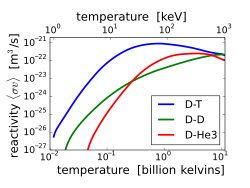Nuclear fusion

Nuclear fusion is the process of making a single heavy nucleus (part of an atom) from two lighter nuclei. This process is called a nuclear reaction. It releases a large amount of energy.[1]
The nucleus made by fusion is heavier than either of the starting nuclei. However, it is not as heavy as the combination of the original mass of the starting nuclei (atoms). This lost mass is changed into lots of energy. This is shown in Einstein's famous E=mc2 equation.
Fusion happens in the middle of stars, like the Sun. Hydrogen atoms are fused together to make helium. This releases lots of energy. This energy powers the heat and light of the star. Not all elements can be joined. Heavier elements are less easily joined than lighter ones. Iron (a metal) cannot fuse with other atoms. This is what causes stars to die. Stars join all of their atoms together to make heavier atoms of different types, until they make iron. The iron nucleus cannot fuse further because of its high nuclear binding energy. The reactions stop. The star eventually cools and dies.[2]
On Earth it is very difficult to start nuclear fusion reactions that release more energy than is needed to start the reaction. The reason is that fusion reactions only happen at high temperature and pressure, like in the Sun, because both nuclei have a positive charge, and positive repels positive. The only way to stop the repulsion is to make the nuclei hit each other at very high speeds. They only do that at high pressure and temperature. The only successful approach so far has been in nuclear weapons. The hydrogen bomb uses an atomic (fission) bomb to start fusion reactions. Scientists and engineers have been trying for decades to find a safe and working way of controlling and containing fusion reactions to generate electricity. They still have many challenges to overcome before fusion power can be used as a clean source of energy.
Nuclear Fusion Media
Fusion plasma in China's Experimental Advanced Superconducting Tokamak
Animation of an electron's wave function as quantum tunneling allows transit through a barrier with a low probability. In the same fashion, an atomic nucleus can quantum tunnel through the Coulomb barrier to another nucleus, making a fusion reaction possible.
M. Stanley Livingston and Ernest Lawrence in front of UCRL's 27-inch cyclotron in 1934. These devices were used for many early experiments demonstrating deuterium fusion.
Fusion of deuterium with tritium creating helium-4, freeing a neutron, and releasing 17.59 MeV as kinetic energy of the products while a corresponding amount of mass disappears, in agreement with kinetic E = ∆mc2, where Δm is the decrease in the total rest mass of particles
The proton–proton chain reaction, branch I, dominates in stars the size of the Sun or smaller.
The CNO cycle dominates in stars heavier than the Sun.
The nuclear binding energy curve. The formation of nuclei with masses up to iron-56 releases energy, as illustrated above.
The electrostatic force between the positively charged nuclei is repulsive, but when the separation is small enough, the quantum effect will tunnel through the wall. Therefore, the prerequisite for fusion is that the two nuclei be brought close enough together for a long enough time for quantum tunneling to act.
The Tokamak à configuration variable, research fusion reactor, at the École Polytechnique Fédérale de Lausanne (Switzerland)
Related pages
| Wikimedia Commons has media related to Lua error in Module:Commons_link at line 62: attempt to index field 'wikibase' (a nil value).. |
Notes
- ↑ "FusEdWeb | Fusion Education". Archived from the original on 2015-01-01. Retrieved 2011-03-18.
- ↑ "Progress in Fusion". ITER.









